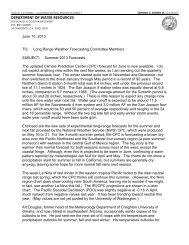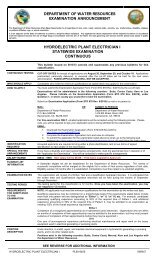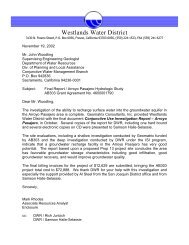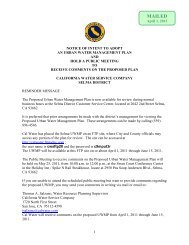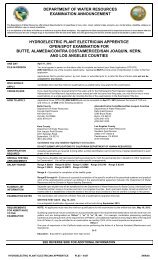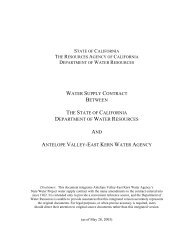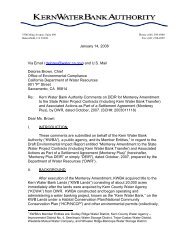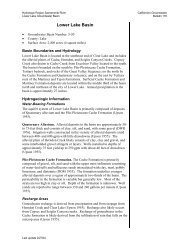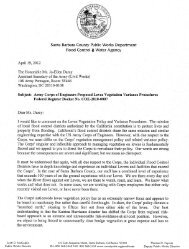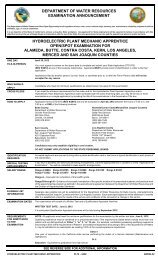Bulletin 1.pdf - California Department of Water Resources - State of ...
Bulletin 1.pdf - California Department of Water Resources - State of ...
Bulletin 1.pdf - California Department of Water Resources - State of ...
You also want an ePaper? Increase the reach of your titles
YUMPU automatically turns print PDFs into web optimized ePapers that Google loves.
APPENDIX E<br />
COLORADO RIVER<br />
Diversions were first made from Colorado River for the irrigation <strong>of</strong><br />
lands in <strong>California</strong> in the 1870s. Over the years this irrigation has increased<br />
tremendously, so that the agricultural economy within <strong>California</strong><br />
dependent upon Colorado River is now <strong>of</strong> significant importance to the<br />
<strong>State</strong> and to the Nation. Furthermore, since completion <strong>of</strong> the Colorado<br />
River Aqueduct by the Metropolitan <strong>Water</strong> District <strong>of</strong> Southern <strong>California</strong><br />
in 1940, a present population <strong>of</strong> more than 4,000,000 in the SoutIl<br />
Coastal Area <strong>of</strong> <strong>California</strong> is dependent upon Colorado River as a source<br />
<strong>of</strong> supplemental water for domestic, industrial, and municipal purposes.<br />
Increasing diversions from Colorado River for irrigation <strong>of</strong> lands in<br />
Oalifornia, together with other diversions for upstream irrigation, were<br />
so great by the early 1920s as to cause deficiencies in supply during dry<br />
years. The urgent need for regulation <strong>of</strong> the river, both for augmentation<br />
<strong>of</strong> the supply during dry years and for control <strong>of</strong> floods, was apparent.<br />
However, preliminary to construction <strong>of</strong> works for river regulation it<br />
was essential that an understanding be reached as to division <strong>of</strong> the waters<br />
between the interests <strong>of</strong> the seven states into which Colorado River extends.<br />
The Colorado River-Compact, sig'ned in 1922 by commissioners representing<br />
the <strong>State</strong>s <strong>of</strong> Arizona, <strong>California</strong>, Colorado, Nevada, New Mexico,<br />
Utah, and Wyoming, and the United <strong>State</strong>s, apportioned the waters <strong>of</strong> the<br />
Colorado River System between the Upper and I-lower Basins <strong>of</strong> the river.<br />
As defined in the compact, the dividing point between the Upper and<br />
Lower Basins is Lee Ferry, a point on the main stream <strong>of</strong> Colorado River<br />
one mile below the mouth <strong>of</strong> Paria River in northern Arizona. In 1923<br />
the legislatures <strong>of</strong> all Colorado River Basin states, except Arizona,ratified<br />
the compact. The <strong>State</strong> <strong>of</strong> Arizona did not ratify the compact until 1944,<br />
when its legislature gave its approval.<br />
Initial legislative efforts in connection with further development on<br />
Colorado River were the so-called Kettner Bills, seeking authorization for<br />
construction <strong>of</strong> the All-American Canal, which were introduced in 1919<br />
and 1920, but failed to come to vote. The first <strong>of</strong> several bills providing<br />
for authorization <strong>of</strong> the Boulder Canyon Project was introduced in 1922<br />
by Congressman Phil D. Swing and Senator Hiram W. Johnson, and<br />
became known as the first Swing-Johnson Bill. The Boulder Canyon<br />
Project Act, as finally passed by the Congress in 1928, provided for construction,<br />
operation, and maintenance <strong>of</strong> a storage dam and power plant<br />
at Black Canyon or Boulder Canyon on the main stream <strong>of</strong> Colorado<br />
River, and construction <strong>of</strong> the All-American Canal to divert water from<br />
the river and convey it to Imperial and Coachella Valleys by a conduit<br />
within the United <strong>State</strong>s. The Secretary <strong>of</strong> the Interior was authorized<br />
to contract for the sale <strong>of</strong> water and power that would assure repaying<br />
the entire cost <strong>of</strong> the dam and power plant, with interest, together with<br />
operation and maintenance expenses, and repayment without interest <strong>of</strong><br />
the cost <strong>of</strong> the All-American Canal under provisions <strong>of</strong> the Reclamation<br />
( 635 )



